Interventional radiology facts for kids

An interventional radiology suite where biopsy, diagnosis or therapies are precisely guided with real-time fluoroscopy
|
|
| Occupation | |
|---|---|
| Names |
|
|
Occupation type
|
Specialty |
|
Activity sectors
|
Medicine, Surgery |
| Description | |
|
Education required
|
|
|
Fields of
employment |
Hospitals, Clinics |
Interventional radiology (often called IR) is a special area of medicine. Doctors who work in IR use amazing medical imaging tools, like X-rays, CT scans, MRI scans, and ultrasound, to guide them during medical procedures.
These doctors perform procedures that are "minimally invasive." This means they use very small cuts or natural body openings instead of large surgeries. They can use tiny needles and wires to reach places deep inside the body.
Contents
What is Interventional Radiology?
Interventional radiology is like having a superpower that lets doctors see inside your body without opening it up completely. They use special cameras and screens to guide their tools with incredible precision. This helps them treat many different health problems.
How Doctors Use Imaging Guidance
Imagine a doctor needing to fix something deep inside your body. Instead of making a big cut to see, an interventional radiologist uses imaging to get a live picture.
- X-ray fluoroscopy: This is like a live X-ray movie, showing bones and some organs as the doctor works.
- CT scan: This takes many X-ray pictures from different angles to create detailed 3D images of your body.
- MRI scan: This uses strong magnets and radio waves to make very clear pictures of soft tissues, like muscles and organs.
- Ultrasound: This uses sound waves to create images, often used for organs like the heart or for seeing babies before they are born.
These images help the doctor guide tiny tools, like thin tubes called catheters, exactly where they need to go.
Types of Procedures in IR
Interventional radiologists perform two main types of procedures: diagnostic and therapeutic.
Diagnostic Procedures
Diagnostic procedures help doctors figure out what's wrong or get more information about a health issue.
- Biopsies: An IR doctor can use imaging to guide a tiny needle to take a small sample of tissue from a tumor or other area. This sample is then checked under a microscope to see if it's healthy or not.
- Contrast injections: Sometimes, doctors inject a special dye (called a contrast agent) into blood vessels or other body parts. This dye makes those areas show up more clearly on imaging scans, helping doctors see problems like blockages.
Therapeutic Procedures
Therapeutic procedures are treatments that directly help a patient get better.
- Medicine delivery: Doctors can use catheters to deliver medicine directly to a specific area, like a tumor, without affecting the whole body.
- Device placement: They can place small devices, like stents, which are tiny tubes that help keep blood vessels or other passages open.
- Angioplasty: This procedure uses a tiny balloon to open up narrowed blood vessels, improving blood flow.
Benefits of Interventional Radiology
One of the biggest advantages of IR is that it's much less invasive than traditional surgery.
- Less pain: Because the cuts are tiny, patients usually feel less pain.
- Faster recovery: People often recover more quickly and can go home sooner.
- Lower risks: There's generally less risk of infection or other problems compared to open surgery.
The real-time imaging also means doctors can be very precise. They can guide their tools exactly to the problem area, making the treatment more effective.
Risks of Interventional Radiology
Even though IR is very safe, there are some things to consider.
- Radiation exposure: Procedures using X-rays or CT scans involve some radiation. Doctors use the lowest amount possible, but repeated exposure can have risks over a long time.
- Bleeding or perforation: Although rare, there's a small chance of bleeding or accidentally poking a hole in an organ. Doctors are highly trained to prevent these issues.
Doctors always weigh the benefits against these small risks to make sure the procedure is the best choice for the patient.
See also
 In Spanish: Radiología intervencionista para niños
In Spanish: Radiología intervencionista para niños

